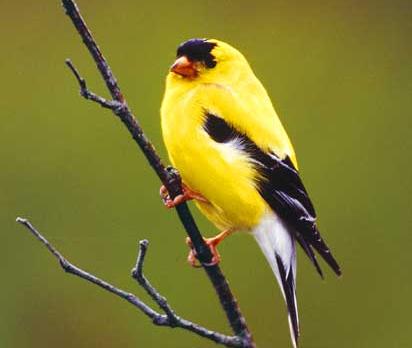Goldfinch - American
American Goldfinch Scientific Name: Carduelis tristis
Sun, 6th October, 2024 - 5:16 pm GMT
Sponsor Ads:

Alternative Name
American Goldfinch Scientific Name: Carduelis tristisBasic Info
The American Goldfinch is a relatively small bird - no larger than your average sparrow. The average mature individual measures approximately four and a quarter inches. Its coloration changes from summer to fall. The summer plumage of the American Goldfinch is a brilliant yellow, with a black spot on its head. The tail has a white-colored bottom with black spots, and a white base that extends from the bottom to the top. It has black wings, striped beautifully with white along either wing, a small white patch complementing each shoulder. In the winter, these colors are all dulled slightly, and females as a whole have a dimmer, less bright color pattern than the average male.
Health
Keeping thistle plants in your backyard will certainly attract the American Goldfinch if you live near a migratory path or in one of the few spots the American Goldfinch lives year round. It will also most likely benefit from having a seed feeder handy. Make sure you keep it stocked with the Goldfinch's favorite seed varieties, like grass seeds, and tree seeds. Also, as with any wild bird, it will appreciate a clean, fresh birdbath to bathe in. Breeding Having only a very short breeding season, the American Goldfinch will find a mate and lay eggs in starting in July until the middle of September. Females will lay a small clutch of around five eggs at a time. These eggs, a light blue in color, need to be incubated by the female for no less than 12 days. During this incubation period, the male will happily feed its mate, caring for her while raising their young. Once the baby Goldfinches have hatched, they will be fed seeds that the mother was fed by the male during the incubation period. Two weeks later, these baby Goldfinches will fledge, and after a total of five weeks after hatching, they will finally learn to live without the aid of their father. The mother will have long since left to find another mate, and raise another brood.Habitat
Common throughout the United StatesBehavior
It can also be found in sparse forests. The American Goldfinch's diet consists entirely of seeds. This may explain why it nests in shrubby areas - it prefers the seeds of a thistle plant, which is a shrubby bush that tends to grow in open areas. That is perfect for the American Goldfinch, and could be a reason why it chooses such areas for breeding purposes. The American Goldfinch will also feast on grass seeds that it finds in open lawns and grasslands. In addition it likes the seeds from flowers and trees! The Goldfinch is a social bird; it forms a flock with other small birds like it, such as other breeds of Finch, the occasional Siskin and others. The American Goldfinch's name is many-layered and interesting to research. Its genus name, Carduelis, refers to its eating habits. Since the American Goldfinch prefers thistle seeds to anything else it was named after this habit, it's genus name meaning literally "thistle-finch." The species name, "tristis", has another interesting explanation. It once meant "sad" or "depressed" in Greek, certainly an inappropriate word for describing this brightly colored bird. Now, it's taken to mean "pale" or "having qualities of paleness", and it's postulated that it refers directly to this bird's winter color scheme.Origin
North AmericaHistory
The American Goldfinch is a welcome visitor to many North American homes. American Goldfinch prefers to make its home in fields where small shrubs are in abundance. They will form a large foraging flock, which may ravage the landscape looking for food. The flock will also help to provide protection from larger predators for. The formation of flocks usually takes place during Migration season, when the American Goldfinch makes its way south. There are only a few places the American Goldfinch can be found at all times of the year, most notably Georgia, a commonly good environment for weather-sensitive birds like the Goldfinch. It can also be found year round in a few scattered spots in the Northern United States.Common Foods
seedsSponsor Ads:
Boob's Law: You always find something the last place you look.
Goldfinch - American
Coded by: BGID® | ALL RIGHTS RESERVED Copyright © 2000-2024
Disclaimer | Privacy | Report Errors / Contact | Credits
















